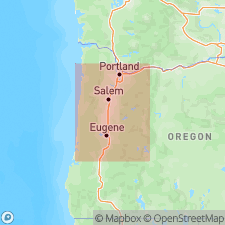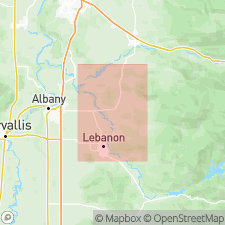
- Usage in publication:
-
- Mehama volcanics
- Modifications:
-
- Named
- Dominant lithology:
-
- Volcanics
- AAPG geologic province:
-
- Cascades province
Summary:
Subaerial Mehama volcanics unconformably underlies Stayton lavas in Salem Hills, center of Willamette Valley southwest of Salem, OR. Probably grades westward into Illahe formation which contains lower-middle Oligocene fossils. [Derivation of name and age not stated]
Source: GNU records (USGS DDS-6; Menlo GNULEX).

- Usage in publication:
-
- Mehama volcanics
- Modifications:
-
- Age modified
- AAPG geologic province:
-
- Cascades province
Summary:
Best exposed near crest of Mehama anticline north and east of Mehama, Marion Co, OR. Described as terrestrial tuffs, lavas, and breccias which for most part were water laid. Contains fossil wood. Thickness as much as 600 ft. Distribution of outcrops shown on geologic map of Salem Hills and North Santiam River basin. Cross sections show unit underlies Stayton lavas. Is evidently comparable in age to Warrendale or Eagle Creek formation in Columbia River gorge. Map shows Oligocene age.
Source: GNU records (USGS DDS-6; Menlo GNULEX).

- Usage in publication:
-
- Mehama volcanics
- Modifications:
-
- Areal extent
- Biostratigraphic dating
- AAPG geologic province:
-
- Cascades province
Summary:
Type area is described by Thayer (1939) in vicinity of Mehama, OR, in North Santiam River valley about 7 mi northeast of Lebanon 15' quad. Geographically extended into Lebanon 15' quad. Tentative names "Scio beds" and "Berlin volcanics" used by Felts (1936, unpub. thesis) are abandoned. About 500 vertical ft of Mehama volcanics are exposed on sides of Prospect Mountain, Franklin Butte, and Hungry Hill. Total thickness estimated about 1500 to 2500 ft. Section on Franklin Butte shows about 250 ft of sandstone, siltstone and tuffs in upper part. Below this is Scio floral zone [list of flora included in report] in about 100 ft of white bedded tuffaceous shale. In basal part of section are about 150 ft of micaceous sandstones in which fragment of marine fossil was found. Presumably overlies Eugene formation. Both are unconformably overlain by Stayton lavas. Age based on fossils is Oligocene. Lower part of formation may range downward into Eocene age.
Source: GNU records (USGS DDS-6; Menlo GNULEX).
For more information, please contact Nancy Stamm, Geologic Names Committee Secretary.
Asterisk (*) indicates published by U.S. Geological Survey authors.
"No current usage" (†) implies that a name has been abandoned or has fallen into disuse. Former usage and, if known, replacement name given in parentheses ( ).
Slash (/) indicates name conflicts with nomenclatural guidelines (CSN, 1933; ACSN, 1961, 1970; NACSN, 1983, 2005, 2021). May be explained within brackets ([ ]).

